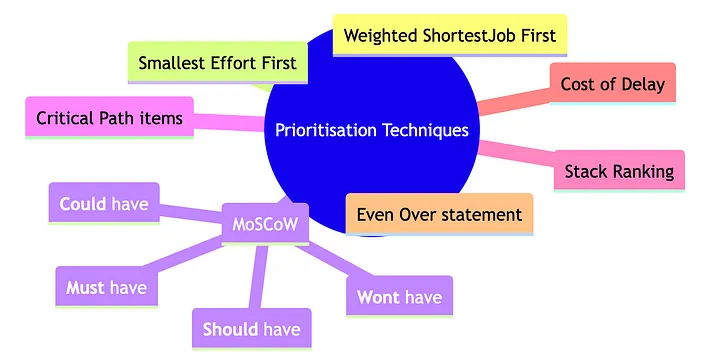
One of the crucial responsibilities of a product owner is to maintain a well-defined, healthy, and prioritised product backlog. A healthy product backlog ensures that the Scrum team has a sufficient number of ready stories for the next two sprints, as well as a high-level plan for the following three months. However, detailing the backlog beyond three months is often unproductive. Despite this, product owners may have a long-term vision encompassing multiple milestones, such as MVP1, MVP2, and the final product, which could take more than a year to develop. So, how do product owners prioritise hundreds of stories and tasks before presenting them to the Scrum team? Let’s explore some commonly used techniques:

The techniques mentioned in diagram above are most commonly used by product owner.
Stack Ranking
With stack ranking, the product owner assigns a numerical rank to each backlog item, indicating its relative importance. The highest-value item is given the top rank (#1), followed by the next important item (#2). The items are arranged in a stack, ensuring that the highest-value item is delivered first before proceeding to the rest.
Even Over Statement
This prioritisation technique is useful in situations where there is ambiguity and requires brainstorming among multiple options. Product owners collaborate with the business and technical teams to discuss trade-offs by considering costs and revenue.
Smallest Effort First
This approach focuses on completing tasks that require the least effort first, while larger tasks are addressed later. While this technique promotes quick delivery and boosts team confidence and morale, it necessitates estimating each story in the entire backlog, which can be time-consuming and requires ongoing re-estimations as new stories are added.
Weighted Shortest Job First
Weighted assessment is synonym for dollar-value.
This technique involves assessing each backlog item’s value in relation to the effort required to deliver it. By calculating a score (value/effort), product owners can determine the priority order. Collaborating with the Scrum team, estimates for both value and effort are gathered to evaluate the value proposition of each item.
MoSCoW
MoSCoW is acronym for Must have, Should have, Can have and Won’t have.
MoSCoW is an acronym representing four categories for backlog features. Must-have items are essential and typically have the most significant impact. Should-have items are also important but can be prioritised after the must-haves. Could-have/good-to-have items are desirable but not immediately necessary, and won’t-have items are clearly indicated as features not required for the product launch.
Critical Path Items
This technique is often used when tasks are dependent on other tasks in backlog or are having external team dependencies. It is also useful when there are multiple squads working on a larger product to layout the dependencies among inter teams. It requires to complete the dependent-on feature/stories to be completed before moving onto dependent story. The dependent-on items are usually non-negotiable feature/stories that must be completed.
Cost of Delay
This technique involves assessing the potential cost of delaying the implementation of a particular feature. Items with higher potential costs of delay are prioritised higher to mitigate any negative consequences.
These techniques offer product owners a range of options to prioritide their backlog effectively based on various factors such as value, effort, dependencies, and impact. Selecting the most appropriate technique or combination of techniques for each situation helps ensure that the product backlog aligns with business objectives and maximises value delivery.
Remember, effective backlog prioritisation requires continuous refinement and collaboration with the Scrum team, stakeholders, and customers to adapt to changing needs and market dynamics.
#LinkedInPowerPlayers #FractionalUnited #Fractional #CTO #Technology #FractionalProductOwner #Fractional #Product #ProductBacklog #Prioritisation

